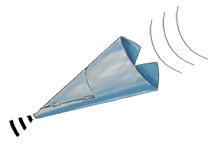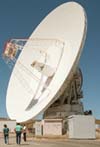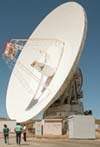Hear tiny sounds with a Super Sound Cone!
What you need:
- A big piece of tag board or poster board, about 18 x 24 inches
- Transparent tape
What to do:
This is so easy!
Just roll the poster board into a cone shape, leaving a small hole (about 1/2 to 1 inch across) at the pointed end. Leave the big end as wide as you can. Then tape the edge into position.
Take your cone outside. Put the small end in your ear. Point the cone in different directions and listen carefully. Notice how different the world sounds with and without the cone to aid your hearing.

This girl can clearly hear her big sister's watch ticking from this far away!
What tiny sounds did you notice with the cone that you didn't notice before?
The cone is a funnel for waves

Like waves in the ocean, sound makes waves in the air. Air jostles back and forth as the sound energy waves pass.
If you put something like paper in the path of the sound wave, it will also vibrate quite a lot. If you give this paper surface the right shape, the sound waves will be funneled to a point. So your super sound cone is a sound funnel!
The same sort of idea makes NASA's giant dish antennas work. These antennas listen for signals from the planetary spacecraft now exploring space far from Earth.

The antenna dish in this picture is 70 meters (about 230 feet) across. This antenna is in Australia. See how tiny the cars look by comparison?
We can't just build a spacecraft, tell it to phone home once in a while, then launch it to Mars or Jupiter! We must have a way to hear its tiny voice and talk to it when it is very far away.
Some of the Deep Space Network antennas are twice as big as the one watching over the sheep above!
Of course, no spacecraft actually communicates by sound. Messages wouldn't get very far, since sound waves can't travel in the vacuum of space! But the spacecraft do send out radio waves, which can travel practically forever. The trouble is, the radio waves spread out and get weaker and weaker the farther they travel.
So NASA's radio wave "ears" must be very big indeed!

These dish antennas don't look much like your sound cone, do they? But the path the radio signals take once they hit the dish is like a folded up cone. Once the signal hits the focus (like the small end of your cone), electronic instruments take over to turn up the volume even more.
Then we can begin to decode the message and figure out what the spacecraft has to show and tell us!








